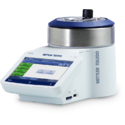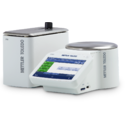Sample preparation for lubricant grease follows the original specifications in the ASTM D566 standard, which is also used in the ASTM D2265 and IP 396 standards and can be seen in the following steps.
Lubricants, Greases
Step1: In order to avoid any cross-contamination, the dropping point cup should be cleaned with solvents such as toluene, isopropanol or mixtures of both solvents, preferably in an ultrasonic bath. Alternatively use disposable aluminum cups.

Step 2: The grease sample is packed into the cup with a spatula that is part of the accessory box. The cup is completely filled with the grease and any excess removed with the spatula.

Step 3: When the cup is full, a metal rod with dimensions corresponding to ASTM D566 is pushed through the grease sample from the smaller opening at the bottom of the cup. The cup is moved down along the rod, turning in a spiral-like movement in order to remove a conical section of the grease. This produces a smooth layer of grease of reproducible thickness inside the cup. It is important that the inner cup walls are completely covered with the lubricant grease - otherwise the filling procedure needs to be repeated.

Step 4: The DP cup containing the sample is then closed with the lid. Together with the collector glass, which is positioned underneath the softening point cup, the whole assembly is mounted into the sample carrier.

Important: As the heat transfer is dependent on the mass of the sample, the mass should be reduced to a reasonable minimum in order to ensure efficient and thorough heat transfer. If the cup was completely filled with the sample, a temperature gradient from the cup wall to the middle of the sample would form. This would lead to liquefaction of the part of the substance closest to the cup wall while the central part of the sample would remain in the original semi-solid state. As a result, the grease dropping point temperature would be significantly higher, or even no drop would be formed during heating.
For optimal grease sample preparation, see this video:
Bitumen, Pitch
Step 1: The sample needs to be melted in a suitable container (pictured below in a brass container) on a hot plate at a temperature not higher than 110 °C above the expected softening point. Homogenize the molten sample thoroughly by stirring.

Step 2: After melting, the sample is poured into the cups using the sample preparation tool. The molten sample is guided with the glass rod into the cup to ensure controlled, bubble-free filling and to avoid uncontrolled spillage of the hot sample. The sample is then cooled down to ambient temperature for at least 30 minutes.

Step 3: Excess from the sample is removed from the cup with a hot knife. Here, the sample preparation tool helps considerably for proper filling of the dropping point cups. Thanks to the support disk, any outside contamination is avoided. Removal of excessive sample from the cup is a very easy and repeatable task because the surface of the support disk is aligned with the rim of the softening point cup.

Step 4: A ball required to weigh the sample is put on top of the cup and the cup with the ball inside is closed with the lid. Together with the collector glass, which is positioned underneath the softening point cup, the whole assembly is mounted into the sample carrier.

Important:
- The sample should be tested within 2 hours after sample preparation.
- Repeated melting of the sample should be avoided, since it will harden the material and increase the softening point.
Resins, Rosins
Resins and rosins are – in principle - prepared in the same way as bitumen. It is recommended that the following points are considered:
- Make sure that the resin sample is not overheated during the melting process. Boiling should definitely be avoided as it affects the sample integrity.
- Make sure that the resin melt is free of air bubbles. Stir the liquid gently with a rod to ensure homogenization and to remove air bubbles.
- Liquefied resin solidifies relatively fast. This needs to be considered particularly when transferring the molten sample into the dropping point cups. It is recommended that the whole sample container is heated (in an oven or with the aid of a hot air blower) and that the cups are filled with molten resin as quickly as possible.
- Avoid excessive overfilling of the sample cup. Once the resin is solidified it is very brittle and the removal of excessive sample becomes a tedious task. Remove the excessive sample with a hot knife shortly after the sample is poured into the dropping point cup (approx. 2 min).
- As with the bitumen samples, repeated heating of solidified resin samples should be avoided. When melting the samples, avoid boiling and air bubbles. Avoid overfilling and remove excess with a hot knife.
For optimal resin sample preparation, see this video:
Waxes
In principle, wax samples are prepared like other molten samples and the sample preparation tool can be used as shown below.
Step 1: The wax sample is melted to 15 to 20 °C above the expected melting point on a hot plate in a suitable container. The molten sample is then carefully poured into the dropping point cup, avoiding the inclusion of air bubbles.

Step 2: Remove excessive sample with the spatula provided in the DP accessory box. Allow 2 hours of solidification at ambient temperature before starting the measurement.

Step 3: The DP cup containing the sample is then closed with the lid. Together with the collector glass, which is positioned underneath the softening point cup, the whole assembly is mounted into the sample carrier.

Solid Samples
Step 1: For powdered samples, the disk-like funnel is mounted on top of the sample preparation tool which guides the powder into the sample cup underneath. The diameter of the funnel hole corresponds exactly with the aperture of the underlying cup. The cup is filled with a small portion of ground sample via the aligned funnel into the cup.

Step 2: The rounded end of the tamping rod is then used to compress the sample in the cup. This procedure is repeated until the cup is completely filled with the sample.

Step 3: The flat part of the tamping rod is then used to compress the sample in order to make it level with the surface of the support disk. The hole of the support disk is then turned to the next cup and the filling procedure is repeated.



